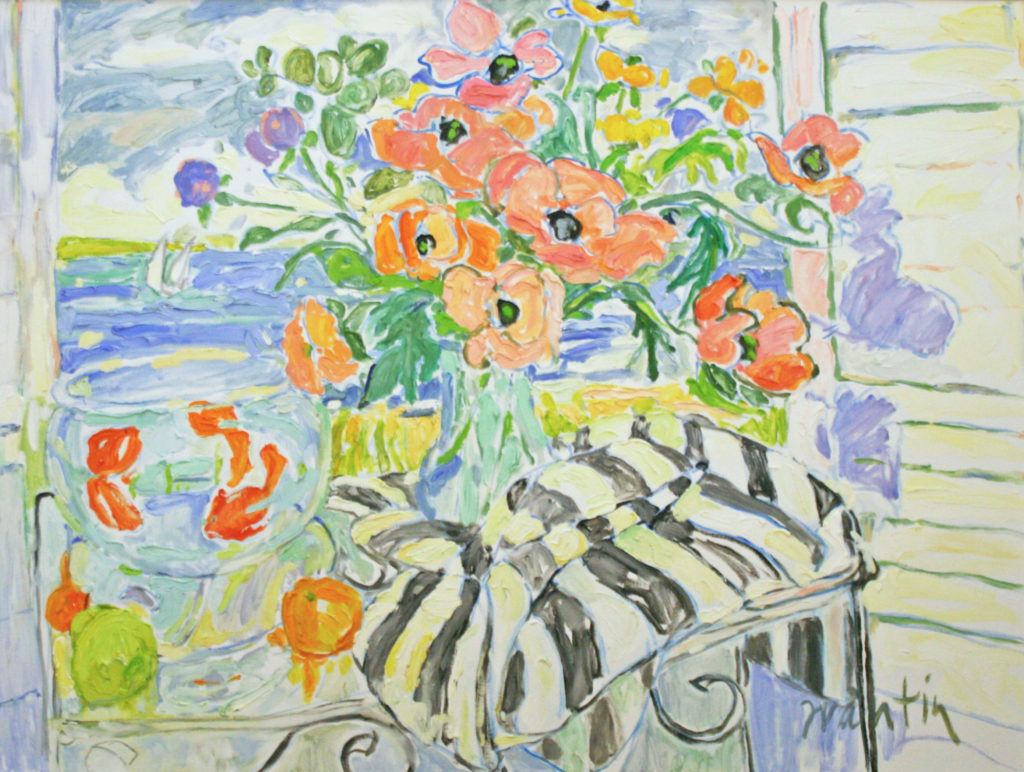Lillia Frantin is a teacher, painter and art historian living on Cape Cod. She first minored in art history before gaining her master’s degree from Pratt Institute in 1968. She was a professor of Painting and Modern Art History for over twenty years, painting and exhibiting professionally in New York, California, New Mexico and on Cape Cod.
While she visited the island to drop off her latest paintings at the gallery, she sat down to answer a few questions.
We started by asking Lillia if her work has changed over the course of her career. Because she has been painting for over 50 years, this was a rather challenging question. Her painting style has remained consistent throughout her career. Her painting style evolves around her use of color and the freshness of her strokes, elements that have always been prevalent in her work. With time, her voice and purpose have developed.
Next, we inquired about her painting process. Lillia contemplates emotion, composition and coloration before painting. She begins her paintings by sketching or creating small thumbnails. Once she has a clear design in mind, she nearly completes the painting in one sitting. In the following weeks, she makes minor adjustments as she finds appropriate; however, her spontaneity and pure strokes come forth the strongest when they are not overworked.

Lillia explained to us why she chooses mainly to paint still lives, often including translucent objects. Lillia said that when she lived in New Mexico with her husband Herb Edwards, she enjoyed painting the interesting open and structural landscapes. The more settled serene landscapes of Cape Cod are less conducive to her style of painting; however, she often paints thumbnails of Cape Cod scenes to put into the window of her still lives. This practice creates openness, interest, rhythm and movement while allowing herself to stay true to well-suited subject matters. The glass she uses represents openness to Lillia. Furthermore, the glass creates distortion in the objects, while the translucency of objects lightly draws the viewer’s eye around the canvas without creating a focal point. This is evident above in her new painting “Still Life with Goldfish & Poppies.”
Lillia also told us about how her work is beautiful and attractive, while also full of meaning and purpose generated from her experience as a student, teacher and painter. She considers her purpose in art making to be both modernist and traditionalist. Modernist in the way that she uses her art to enlarge the viewer’s experience. Traditionalist in the classic turn century idea of what art means — “optimism, hopefulness, romanticism, idealism and beauty”.
In the interview, Lillia’s words best capture her perspective on her still life paintings.
“They are still lifes but they are really about nature and about society and about changing people’s awareness of themselves. I like to leave them at a point where the viewer becomes the person who finished the painting and understands the painting to be their own.”
Her newest paintings are inspired by the cheerful and lively feeling of summertime. Lillia paints from her Cape Cod studio which overlooks her gardens and is filled with gentle breezes and light from the windows. Each of her paintings, whether large or small is an attempt to capture the energy she feels in the studio.
These two paintings feature similar compositions, of plump flower arrangements that fill the square canvas. Both paintings create openness, the poppies with the open beach background, and the hydrangeas with the lightly painted green background. Holding true to much of her work neither painting has a true focal point, they both use loose, organic brush strokes and brilliant coloration.
Through an application of paint both thick and thin, using light and quick dancing brushwork or slow laying of paint ‘wet in wet’, Lillia creates depth, richness and balance. She created imbalance and then sought out ways to re-balance, a rhythm between feelings of strength in one area, gentleness in another. This strategy is especially visible in her painting of poppies. In the poppies, she creates a dark pop of contrast with thick black and white paints. The deep black paint also anchors the playful, bright, light pedals.
The hydrangeas contain lighter and more translucent organic layers. In this work, she uses more muted tones to create a serene and peaceful impression. Despite being more muted the painting holds true to her purpose of creating “beauty” and allowing each person to resonate with different elements and emotions within the paintings.
To view more of Lillia’s paintings please click here.

